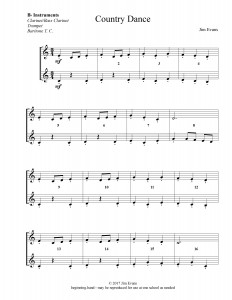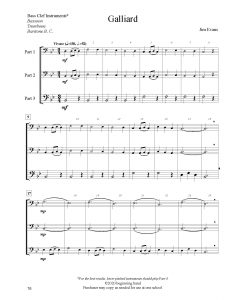Elementary Solo and Ensemble Bundles
Two flex band accompaniments added!!
- Elementary Solos, Volume 1 , Volume 2, and Elementary Ensembles Volume 1 available
- Ranges limited so that students can focus on rhythmic accuracy, tone quality, dynamics, and expression.
- Rhythms are limited to whole, dotted half, half, quarter, and paired eighth notes. Rhythms that even the youngest musicians can count! No syncopation!
- Each piece is about one to two minutes in length to accommodate the limited stamina of younger players.
- A variety of styles and moods to motivate students
- Every measure of each part is numbered! You're welcome! 😉
- Solo books for Flute/Oboe, Bb treble, Eb treble, Tenor Saxophone, Horn, Bass Clef, Tuba, Bells/Xylophone include accompaniment options: piano/keyboard (book included), guitar (book included), and mp3 accompaniment files.
- Duets may be performed by any two instruments, with like or mixed instrumentation, but if you use mixed instrumentation you may have better results if upper instruments play the top line and lower instruments play the bottom line. Also, it may be preferable to avoid having two tubas, as the results may be less desirable.
- Trios should be performed by two higher pitched instruments and one lower pitched instrument. Parts 1 and 2 could be flute, clarinet, alto sax, tenor sax, trumpet, or horn. Part 3 should be at least one octave lower, and should be bassoon, bass clarinet, baritone saxophone, trombone, baritone, or tuba.
- Big bundle now includes downloadable flex band accompaniments of My Happy Song and A Walk in the Park... with Zombies.
Elementary Solos, Volume 1
A collection of twelve solos written with the youngest players in mind!
- Ranges limited so that students can focus on rhythmic accuracy, tone quality, dynamics, and expression. The first six pieces are limited to Bb - F concert, the next six are limited to Bb - G concert.
- Rhythms are limited to whole, dotted half, half, quarter, and paired eighth notes. Rhythms that even the youngest musicians can count! No syncopations!
- No pick-ups! Each piece starts on a downbeat so the kids can come in with confidence!
- Each piece is between 1 and 2 minutes in length to accommodate the limited stamina of younger players.
- A variety of styles and moods to motivate students
- Every measure of each part and score is numbered! You're welcome! 😉
- Solo books for Flute/Oboe, Bb treble, Eb treble, Tenor Saxophone, Horn, Bass Clef, Tuba, Bells/Xylophone
- Accompaniment options: piano/keyboard (book included), guitar (book included), mp3 accompaniment files (included). Accompaniment files may also be streamed or downloaded here.
View a Sample Page (Bb treble - Nocturne)
Elementary Solos, Volume 2
A collection of twelve solos written with the youngest players in mind!
- Ranges limited (Bb - Ab concert) so that students can focus on rhythmic accuracy, tone quality, dynamics, and expression.
- Rhythms are limited to whole, dotted half, half, quarter, and paired eighth notes. Rhythms that even the youngest musicians can count! No syncopations!
- Each piece is between 1 and 1½ minutes in length to accommodate the limited stamina of younger players.
- A variety of styles and moods to motivate students
- Every measure of each part and score is numbered! You're welcome! 😉
- Solo books for Flute/Oboe, Bb treble, Eb treble, Tenor Saxophone, Horn, Bass Clef, Tuba, Bells/Xylophone
- Accompaniment options: piano/keyboard (book included), guitar (book included), and mp3 accompaniment files. Accompaniment files may also be streamed or downloaded here.
Elementary Ensembles, Volume 1
A bundle including Elementary Duets Vol. 1 and Elementary Trios Vol. 1
- Ranges limited so that students can focus on rhythmic accuracy, tone quality, dynamics, and expression.
- Rhythms are limited to whole, dotted half, half, quarter, and paired eighth notes. Rhythms that even the youngest musicians can count! No syncopation!
- Each piece is about one minute in length to accommodate the limited stamina of younger players.
- A variety of styles and moods to motivate students
- Every measure of each part is numbered! You're welcome! 😉
- Duets may be performed by any two instruments, with like or mixed instrumentation, but if you use mixed instrumentation you may have better results if upper instruments play the top line and lower instruments play the bottom line. Also, it may be preferable to avoid having two tubas, as the results may be less desirable.
- Trios should be performed by two higher pitched instruments and one lower pitched instrument. Parts 1 and 2 could be flute, clarinet, alto sax, tenor sax, trumpet, or horn. Part 3 should be at least one octave lower, and should be bassoon, bass clarinet, baritone saxophone, trombone, baritone, or tuba.
- Books for Flute/Oboe, Bb treble, Eb treble, Tenor Saxophone, Horn, Bass Clef, Tuba, Bells/Xylophone
Notes
Duets
Sneaking Around
Meter: 4/4
Key: Bb
Range: A - G
Focus: Staccato, Slur, Phrasing, Dynamic Contrast
Country Dance
Meter: 3/4
Key: Bb
Range: A - G
Focus: Staccato, Triple Meter, Phrasing
All Aboard!
Meter: 4/4
Key: C minor
Range: Bb - Ab
Focus: Staccato, Slur, Phrasing, Dynamic Contrast,
Note: The second part on this piece may be especially challenging for young flute, oboe, and trombone players.
Give and Take
Meter: 3/2
Key: Bb
Range: Bb - F
Focus: Interplay between voices, especially contrasting staccato and legato, Triple Meter
Note: The meter signature of 3/2 allows for livelier rhythmic content without presenting sixteenth notes. Students should be able to read it in 6/4, then perform it in three when they get a "feel" for it.
Night Song
Meter: 4/4
Key: Eb
Range: Ab - Ab
Focus: Legato, Phrasing, Balance
Adagietto
Meter: 3/4
Key:Eb
Range: Ab - Ab
Focus: Legato, Phrasing, Balance, Independence
Trios
Parlor Dance
Meter: 4/4
Key: Bb
Range: A - G
Focus: Staccato, Slur, Phrasing
Bow and Curtsy
Meter: 3/4
Key: Eb
Range: Ab - G
Focus: Pickups, Staccato, Triple Meter
Hopscotch
Meter: 4/4
Key: Eb
Range: Ab - Ab
Focus: Staccato, Balance
Galliard
Meter: 3/4
Key: Bb
Range: A - G
Focus: Phrasing, Balance
On a Carousel
Meter: 4/4
Key: Eb
Range: Ab - Ab
Focus: Pickups, Independence
Hymn
Meter: 3/4
Key:Eb
Range: Low G - Ab
Focus: Legato, Phrasing, Balance
Elementary Duets, Volume 1
A collection of six duets written with the youngest players in mind!
- Ranges limited so that students can focus on rhythmic accuracy, tone quality, dynamics, and expression.
- Rhythms are limited to whole, dotted half, half, quarter, and paired eighth notes. Rhythms that even the youngest musicians can count! No syncopation!
- No pick-ups! Each piece starts on a downbeat so the kids can come in with confidence!
- Each piece is about one minute in length to accommodate the limited stamina of younger players.
- A variety of styles and moods to motivate students
- Every measure of each part is numbered! You're welcome! 😉
- Duets may be performed by any two instruments, with like or mixed instrumentation, but if you use mixed instrumentation you may have better results if upper instruments play the top line and lower instruments play the bottom line. Also, it may be preferable to avoid having two tubas, as the results may be less desirable.
- Books for Flute/Oboe, Bb treble, Eb treble, Tenor Saxophone, Horn, Bass Clef, Tuba, Bells/Xylophone
Notes
Sneaking Around
Meter: 4/4
Key: Bb
Range: Low A - G
Focus: Staccato, Slur, Phrasing, Dynamic Contrast
Country Dance
Meter: 3/4
Key: Bb
Range: Low A G
Focus: Staccato, Triple Meter, Phrasing
All Aboard!
Meter: 4/4
Key: C minor
Range: Bb - Ab
Focus: Staccato, Slur, Phrasing, Dynamic Contrast,
Note: The second part on this piece may be especially challenging for young flute, oboe, and trombone players.
Give and Take
Meter: 3/2
Key: Bb
Range: Bb - F
Focus: Interplay between voices, especially contrasting staccato and legato, Triple Meter
Note: The meter signature of 3/2 allows for livelier rhythmic content without presenting sixteenth notes. Students should be able to read it in 6/4, then perform it in three when they get a "feel" for it.
Night Song
Meter: 4/4
Key: Eb
Range: Ab - Ab
Focus: Legato, Phrasing, Balance
Adagietto
Meter: 3/4
Key:Eb
Range: Ab - Ab
Focus: Legato, Phrasing, Balance, Independence
Elementary Trios, Volume 1
A collection of six trios written with the youngest players in mind!
- Ranges limited so that students can focus on rhythmic accuracy, tone quality, dynamics, and expression.
- Rhythms are limited to whole, dotted half, half, quarter, and paired eighth notes. Rhythms that even the youngest musicians can count! No syncopation!
- Each piece is about one minute in length to accommodate the limited stamina of younger players.
- A variety of styles and moods to motivate students
- Every measure of each part is numbered! You're welcome! 😉
- Trios should be performed by two higher pitched instruments and one lower pitched instrument. Parts 1 and 2 could be flute, clarinet, alto sax, tenor sax, trumpet, or horn. Part 3 should be at least one octave lower, and should be bassoon, bass clarinet, baritone saxophone, trombone, baritone, or tuba.
- Books for Flute/Oboe, Bb treble, Eb treble, Tenor Saxophone, Horn, Bass Clef, Tuba, Bells/Xylophone
Notes
Parlor Dance
Meter: 4/4
Key: Bb
Range: A - G
Focus: Staccato, Slur, Phrasing
Bow and Curtsy
Meter: 3/4
Key: Eb
Range: Ab - G
Focus: Pickups, Staccato, Triple Meter
Hopscotch
Meter: 4/4
Key: Eb
Range: Ab - Ab
Focus: Staccato, Balance
Galliard
Meter: 3/4
Key: Bb
Range: A - G
Focus: Phrasing, Balance
On a Carousel
Meter: 4/4
Key: Eb
Range: Ab - Ab
Focus: Pickups, Independence
Hymn
Meter: 3/4
Key:Eb
Range: Low G - Ab
Focus: Legato, Phrasing, Balance




